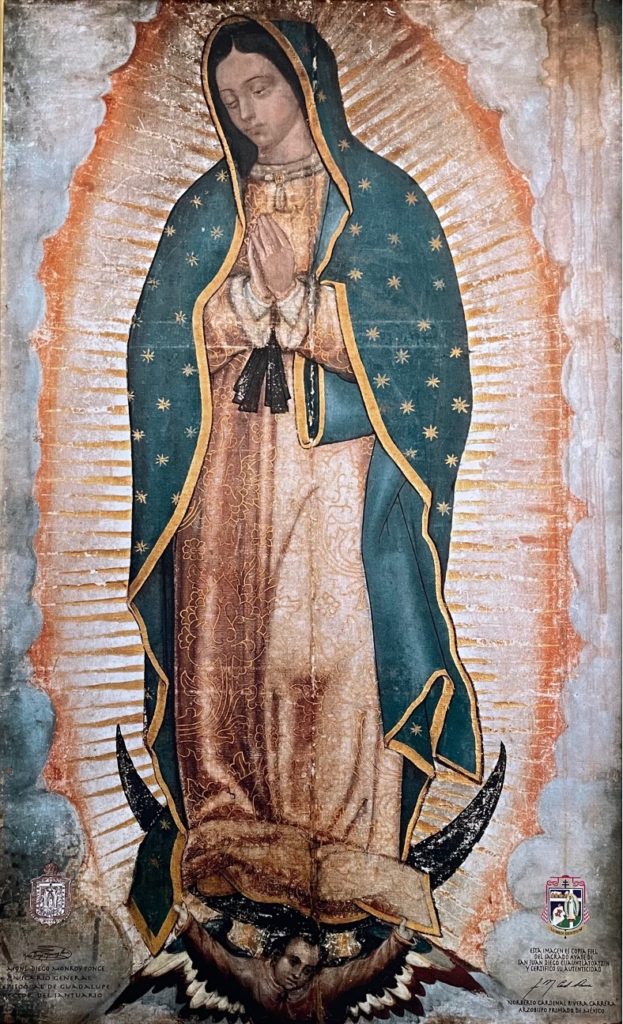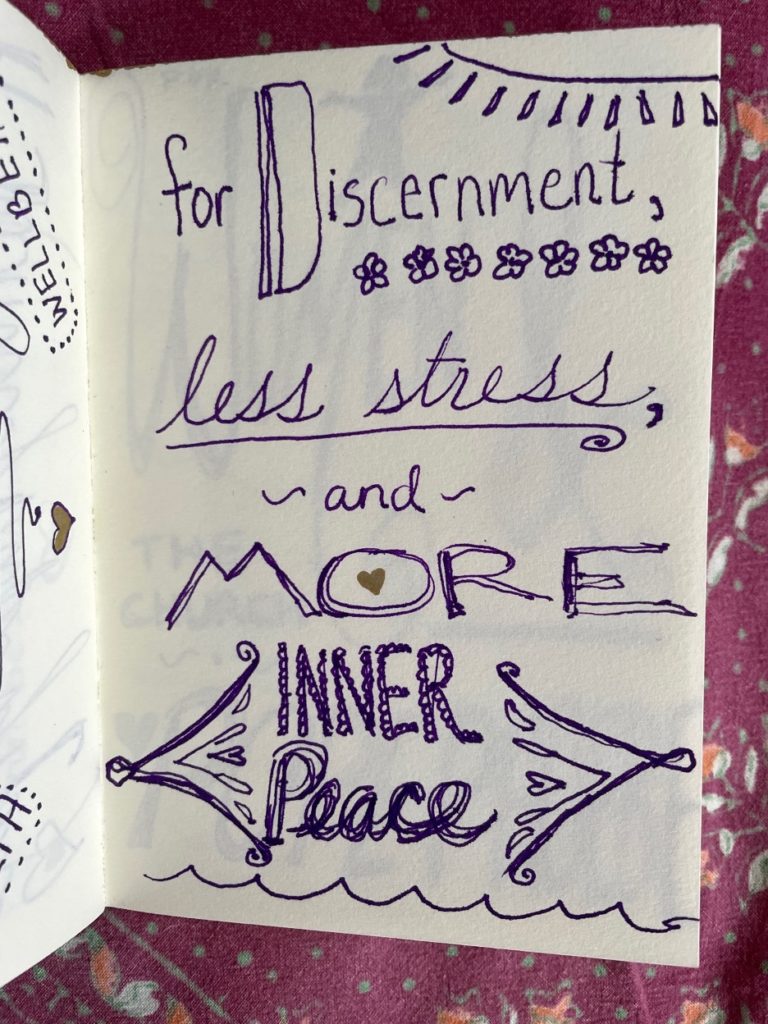Butterflies, Guadalupe, and the Grace of Others
What a joy to spend the first week of September in beautiful, vibrant, complicated, art-infused Mexico City as part of a pilgrimage with the two-years-young organization Discerning Deacons, to celebrate the Feast of Deacon St. Phoebe at the Basilica of Our Lady of Guadalupe. There were 60 of us from North and South America, primarily women but a few men including two American Jesuits and a Brazilian archbishop from the Amazon. I’m still processing everything we experienced and will be for some time, I suppose, which is how these things go.
For me a running theme became the butterfly. I kept seeing them on murals, billboards, clothing, and trees. God invites us into that kind of radical butterfly transformation, from a many-legged crawling creature to a winged beauty, with the mysterious time in the middle as a chrysalis.
To me Our Lady of Guadalupe came to represent this transformational possibility. She emerged as a vision in 1531 to an indigenous man Juan Diego Cuahtlatoatzin, asking him in his native language to have the bishop build a church in her honor there. He tried but struggled to be heard by the hierarchy (sound familiar?). She appeared again and he said “Why would you choose me?” He felt he was too poor and powerless to make an impact. But she consoled him, saying “Am I not your mother?” And she kept at him until at last he succeeded, filling his cloak with roses (which were out of season yet he found them growing on the hillside where she told him to look) and showing the bishop the image of her miraculously printed on his cloak.

He was transformed through his relationship with the Divine Mother. And she herself emerges as a transformational figure who occupies both/and, at a dark and painful time when colonial powers had declared victory over a decimated indigenous civilization. Our Lady of Guadalupe manages to be both Tonantzin (“our mother” in Nahuatl language) and Mary Mother of God for the Spanish colonizers, perhaps a figure of integration and compromise and peace. We learned from an indigenous Mexican priest that her hands may appear to be in a prayer position but that she’s actually clapping, and has one knee raised to show she is engaged in an indigenous dance! We also learned that some say she is backed by the sun, whereas the matriarchal indigenous teaching is that she IS the radiant sun Herself.
As part of the pilgrimage, we were encouraged to bring with us the prayers of our community. I had never done anything like that before, and the experience brought me a new understanding of the purpose and power of prayer. I asked family, friends, members of my WHIMM (Washington Home Inclusive Monthly Mass) community, folks I ran into at the donut hour at my parish Holy Trinity, and friends on Facebook. People I don’t know that well shared important and loving concerns that are weighing on their hearts, and it changed my relationships with them because of it.
I was deeply honored and humbled to carry those prayers with me. I handwrote them in a little book over the course of the week before the trip. I wasn’t sure I’d have time to record them all, because in the days and hours leading up to my departure, I was flooded with texts, emails, WhatsApp and Facebook messages, voicemails—I was worried I’d lose track of them. But turns out my flight was delayed five hours, so I sat at the airport and drew out each intention on its own page, decorating them with loving attention in purple ink. I later realized that no one at the airport seemed stressed about the delay—unusual for the typically high-strung DC crowd. A little miracle right there!
I brought the booklet full of prayers to the sacred site of the Basilica of Our Lady of Guadalupe on the Feast of St. Phoebe—what a powerful intersection of feminine energy! Our group celebrated a private Mass there with inspiring women from among the pilgrims proclaiming the word and preaching the homily. We then went into the crowded shrine and viewed the cloak with the revered image of Our Lady. Afterwards we had time to meander the grounds on our own. I found a quiet spot next to a garden, where I sat among flowers and read each page of my community’s prayers, offering them up. I anointed the book with some sacred oil called “Sun of Success” that I’d brought with me on the trip. I wasn’t sure what else to do except breathe, be, and trust that the Holy Spirit wanted all these good things, too.

Overall on the pilgrimage I learned a lot about the North and South American efforts to mobilize for the church’s approval of the restoration of women deacons. I’m of course in the “all the way” camp of women priests, bishops, and pope—and a transformed priesthood at that–but for now I get why this group is framing their work this way. There are many visionary and practical people working on the effort, which if approved will help women already doing diaconal work: on the front lines in Brazil protecting the Amazon, working as chaplains in American prisons and detention centers, preaching the Word, centering the voices of the poor, running parishes, caring for those on the margins everywhere.
The trip was infused with beautiful music, multiple languages, some tears, and lots of laughter. A good sense of humor turns out to be essential at times and I met some hilarious fellow pilgrims who made it fun. I tried new foods including toasted grasshoppers on guacamole which was surprisingly delicious. One friend and I managed to work in a tour of the Frida Kahlo house, which was a thrill for a painter like myself, seeing her studio and gorgeous garden and even a butterfly collection framed over her bed.
I decided this summer to apply for ordination to the priesthood with Roman Catholic Women Priests. Being on this pilgrimage gave me time to reflect on what it means to be part of something bigger, while still walking my own unique path. I don’t speak Spanish, but we sang many beautiful songs every day in Spanish, and we had interpretation happening constantly so that we could all understand each other. One night I realized I was dreaming in Spanish, and the words that echoed for me were “Los Otros”—the others. Praying for others, being one with others, journeying with others, transforming with others, the grace of others.

We had a beautiful image to pray with as part of the pilgrimage, a painting by Laura James called Recibanla, Receive Her. It depicts Deacon Phoebe and Our Lady of Guadalupe leading a crowd of pilgrims from Mexico City to the Vatican, accompanied by a dove, some bees, and if you look closely, one lone purple butterfly fluttering up ahead to the Vatican.
How does the butterfly show up in our lives? What can this transformational creature reveal for us? What imagination do we need, as caterpillars, to emerge into our full potential? How can los otros help us get there? And how can we be that support for one another?

One Response
The first “transubstantiation” in history happened in the Blessed Virgin Mary’s body.